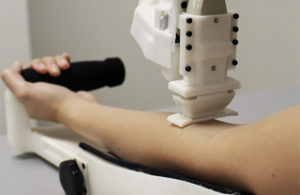
[Image by Unnati Chauhan, provided by Rutgers University]
Researchers at Rutgers University in New Jersey have created a blood-sampling robot that performed as well or better than people.
That’s according to the first clinical trial results that the researchers are touting related to their automated blood drawing and testing device.
The device provides quick results and the researchers believe it could allow healthcare providers to spend more time treating patients in hospitals and other settings.
The results, published in the journal Technology, were comparable to or exceeded clinical standards, with an overall success rate of 87% for the 31 participants whose blood was drawn. For the 25 people whose veins were easy to access, the success rate was 97%.
The device combines ultrasound imaging and miniaturized robotics to identify suitable vessels for cannulation and robotically guide an attached needle toward the lumen center. It includes a module that handles samples and a centrifuge-based blood analyzer, and could be used at bedsides and in ambulances, emergency rooms, clinics, doctors’ offices and hospitals, according to Rutgers.
The university cited previous studies that found clinicians fail at venipuncture in 27% of patients without visible veins, 40% of patients without palpable veins and 60% of emaciated patients. Venipuncture is also among the leading causes of injury to patients, according to a study in the Journal of the Association for Vascular Access. It also leads to injury in clinicians, according to a study in Journal of Emergency Nursing. Difficulties accessing veins can increase procedure time, require more staff and cost more than $4 billion a year in the United States, according to other studies cited by the researchers.
They believe the device might one day be useful in other areas of vascular access, such as IV catheterization, central venous access, dialysis and arterial line placement.
“A device like ours could help clinicians get blood samples quickly, safely and reliably, preventing unnecessary complications and pain in patients from multiple needle insertion attempts,” said lead author Josh Leipheimer, a biomedical engineering doctoral student in the School of Engineering at Rutgers University-New Brunswick, in a news release.
Next steps include refining the device to improve success rates in patients with difficult-to-access veins. Data from this study will be used to enhance artificial intelligence in the robot to improve its performance.